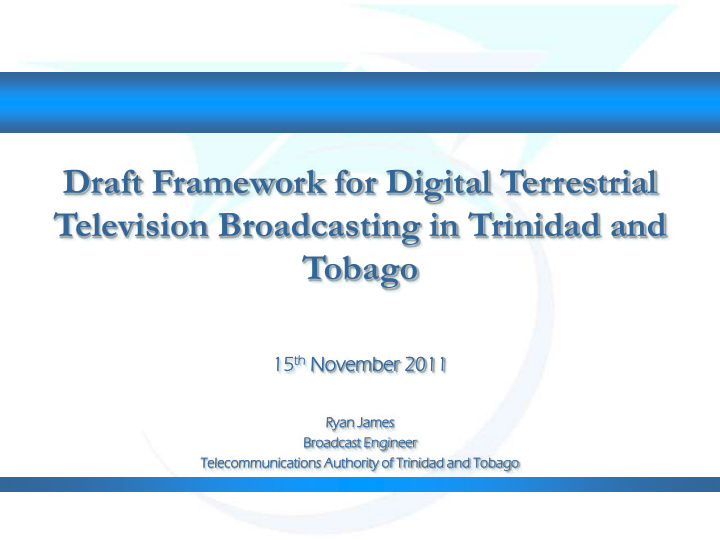



Draft Framework for Digital Terrestrial Television Broadcasting in Trinidad and Tobago 15 15 th th Novemb ember er 2011 11 Ryan n James es Broa oadc dcast st Engine neer Telec lecommuni nication tions s Author ority ity of Trini nida dad d and Tobago go
Digital Terrestrial Television (DTT) Applies to broadcasts that are land based (terrestrial) i.e. ‘Free To Air’ Impacts on existing broadcasters required to switchover Impacts on new entrants granted a concession for digital television broadcasting 2
Why Go Digital? Conformance to global change to digital terrestrial television broadcasting Spectrum efficiency means more programmes Digital Dividend Improved quality of services delivered to the public 3
DTT Framework Objectives Recommend a migration timeframe and key milestones for analogue to digital switchover (DSO) Recommend a standard for DTT broadcasting Recommend an approach for DSO Highlight the role of and impact on the various key stakeholders 4
Switchover Timeframe Factors contributing to the development of a switchover timeframe: Global analog to digital switchover Switch-off dates by other countries Availability of digital TV sets and Set Top Boxes (STBs) Readiness of existing TV broadcasters Entities willing to deploy DTT networks i.e. signal distributors 5
Switchover Timeframe Distinct Phases of DSO: Digital ‘Switch On’ - the introduction of digital broadcasting services Simulcast Period - analogue and digital will be broadcast simultaneously Analogue ‘Switch Off’ - termination of analogue transmission 6
Switchover Timeframe ITU Deadline Authorization of Protection of Signal analogue Distributors broadcasting expires External Factors 2008 2009 2010 2011 2012 2013 2014 2015 Preparatory Work Internal factors Drafting of DTT Framework DTT Working Group Rollout of DTT Service Providers 7
DTT Broadcasting Standard The main technology standards used globally: Digital Video Broadcasting (DVB-T) in Europe Advanced Television Systems Committee (ATSC) in North America Integrated Services Digital Broadcasting (ISDB-T) in Japan Region 1 countries adopted the DVB-T standard (RRC- 06) No recommendation by the ITU or a standardization in the Caribbean by CITEL for a Region 2 DTT standard. 8
DTT Broadcasting Standard 9
Approach To Implementation Policy Driven Approach – transition guided by established processes and plans agreed upon by all stakeholders Moratorium placed on analog terrestrial TV roll-out Establishment of an early and fixed ‘Switch Off’ date Authorization of signal distributors owning and operating the transmission facilities with broadcasters seeking to provide services Signal Distributors to be selected through a competitive evaluation process 10
Approach To Implementation Signal Distributor A common carrier which makes its infrastructure available for hire Ensures optimal utilization of national resources and spurs rapid growth of new value added services The traditional broadcaster is no longer involved in site acquisition, transmitting, infrastructure development and operation 11
Approach To Implementation A signal distributor introduces benefits such as: Lower transmission costs per broadcaster Better efficiency in spectrum management Lower set up costs for new broadcasters Uniform coverage of the broadcast signal Single Frequency Network (SFN) vs Multi- Frequency Network (MFN) configuration 12
Approach To Implementation Single Frequency Network (SFN) configuration 13
DTT Key Issues Framework identifies the key issues and impact surrounding the introduction of digital terrestrial broadcasting Policy and Regulatory Considerations Impact on Broadcasters Impact on Consumers 14
Developments To Date Stakeholder Consultation Process completed Framework for DTT broadcasting services drafted DTT Working Group with key stakeholders established 15
The Way Forward Recommendations from DTT Working Group Finalize DTT Framework Develop Migration Plan and Implementation Strategy Authorize Signal Distributors Develop Consumer Awareness and Education Campaign 16
The End Ryan James Broadcast Engineer Telecommunications Authority of Trinidad and Tobago Email: rjames@tatt.org.tt Phone: 1-868-675-8288 Fax: 1-868-674-1055 17
Recommend
More recommend